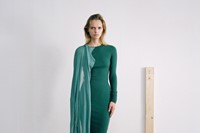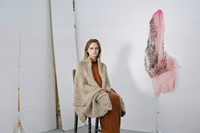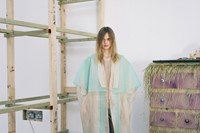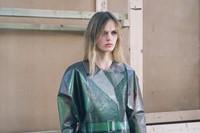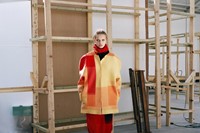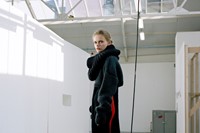Inspired by layering and an emphasis of colour and silhoette in this summer's Royal College of Art graduate MA collections, Nobuko Tannawa styled...
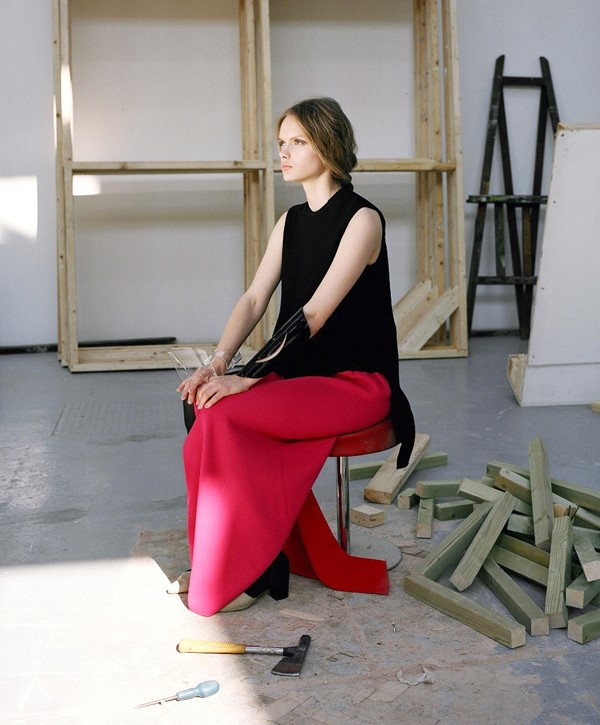
In June, the Royal College of Art's MA Fashion students presented their final collections. One of the key trends was layering and covered skin, with an emphasis on shapes and silhoettes. With this in mind, Nobuko Tannawa styled four of the graduates' collections – Ruth Green, Victoria Alice Hill, Abnit Nijjar and Itziar Vaquar – and spoke with each of them about their inspirations and working processes.
What was the inspiration for your graduate collection?
Ruth Green: It drew inspiration from the work of Egon Schiele, with colours and textures melting into one another. Combining felted lambs wools, fine high shine viscoses and layers of sheer silk chiffon the collection embodies the notion of juxtaposition. Large scale intarsias take inspiration from Francis Giacobetti’s photography of Francis Bacon cascaded across oversized curved silhouettes, and slouched lambs wool and mohair marled intarsia hand knits with layers of soft, disintegrating chiffon emerging from beneath. Large billowing expanses of transparent colour melt from structured felt sections of garments with bold Bauhaus influenced graphic elements further contrasting against the soft elements of the collection.
Victoria Alice Hill: I was mainly concerned with the way garments control and release around the body, creating both movement and shape, which lead to making the garments appear seamless accentuating the pattern shapes with the ribs. F. Scott Fitzgerald’s Tender is the Night has also influenced me to create a look that is relaxed yet glamorous. I explored this dichotomy by looking at resort-style twenties photography and the contemporary oversized layering seen in today’s lounge wear to influence the silhouette shapes, feel and styling of my garments. The deep jewel colours I have used to define each look were inspired by the rich tones and qualities of light captured in Helmut Newton’s Polaroid photographs.
Abnit Nijjar: I am really into fabrics and began by making my own textiles – combining artificial textures against natural fibres. I loved the impolite contrast of the two together and kept a sense of this nonconformity throughout the collection. Alongside this, cutting out generous shapes around the body and overlapping fabric, started a story of revealing layers within long silhouettes. My references ranged from blobby floral motifs cut out of decorative Victorian lace trims to pop-glam TOTP2 to oversized pieces from my loser-age wardrobe, circa All Saints and Cruel Intentions. I don’t feel like I relied on one singular theme, it was a lot more personal. I've always been interested in establishing a vibe and an attitude with my clothes, making my overall statement spirited. Noughties Prada and Gucci, forever Yohji Yamamoto and the party women of early Guy Laroche and YSL provide the backbone to my understanding of womenswear.
Itziar Vaguar: My inspiration was the idea of air understood as a palpable form of absence as well as our tendency to value speed and instantaneity originating a culture of lightness. Everything is in continuous transformation so nothing remains solid. It’s about the feeling of living in a liquid world in which everything melts into air.
I realised that many of the graduates were covering the models with layers and saw a lot of long skirts instead of skin. Were you conscious of it?
RG: I think there has been a big trend for this. In terms of my collection I was working with sheer expanses of Viscose, with knit so fine it created a feeling of a second skin. The body might be covered up but you can still see the silhouette through the sheer fabrics and the skin tone through the fine gauge knits. I think it's very sexy.
VAH: My shapes progressed naturally out of my drawings and research. I have never been overly preoccupied about whether my garments show skin or not. I think it can be just as provocative to show less skin. I want the woman wearing my designs to have the confidence to know she doesn’t need to show skin to look good.
AN: Subconsciously, probably yes. I was more conscious of the attitude of my girl and getting across a sense of femininity. I am forever inspired by unpretentious ‘come-as-you-are’ glamour, where you kind-of collage what you wear and end up layering everything you own! Although my collection is loaded with long silhouettes, thigh-high slits, loose overlapping fabric, open back cuts and transparency in the lace give the clothes discreet sexiness.
IV: I think it is because we are unconsciously influenced not just by the fashion world but also by certain factors from our actual society.
What is your strength as a designer?
RG: The beauty of knitwear design is the freedom it gives you in terms of fabric development, creating and fully fashioning pieces to do exactly what you want them to do. Combining unusual fibres and creating unique fabrics, the feeling of craft rejuvenation, taking old techniques and giving them a modern twist. I love experimenting with the juxtaposition between sculpted three-dimensional shapes and fluid draped fine gauge pieces. Colour is so important when I am designing it is ultimately my starting point.
VAH: I am almost obsessively technical in my knitting – I love experimenting with stitches and the different shapes and textures that I can build from them. I have an eye for quality and detail, and I believe one of my strengths as a designer is the intelligent construction of my garments.
AN: I would say the ability to see inspiration and potential in pretty much anything and manipulate it for the design process.
IV: To consistently work hard.
What are your plans for the near future?
RG: Freelance designing and knitting. Working with Skunkfunk and Rowan for A/W12.
VAH: I am working on a couple of ongoing projects whilst I look for a permanent job in knitwear design.
AN: To travel lots, listen to more music and keep drawing.
IV: Find a job I can enjoy and where I will continue learning.
Credits
Photography Rasha Kahil
Stylng & Interviews: Nobuko Tannawa
Hair: Yumi Nakada
Make-up: Abigail Johnson using Mac
Model: Helene Desmettre @ Elite
Styling Assistant: Aiko Koike
Special thanks to Tim Steer and the RCA sculpture studio
